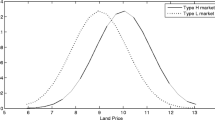Abstract
We develop a two equation error correction model to investigate determinants of and dynamic interaction between changes in profits and number of firms in retailing. An explicit distinction is made between the effects of actual competition among incumbants, new firms competition and potential competition from firms outside the market. Effects of cost, demand and general income changes on profitability are investigated to gain insight in the role of retailing in the cost, demand and wage inflationary processes. The relative importance of profitability, growth and unemployment as determinants of net entry are studied. The model is tested using a panel data set of 36 Dutch shoptypes covering the 1977–1988 period.
Similar content being viewed by others
References
Acs, Z. J. and D. B. Audretsch, 1989, ‘Small-firm Entry in US Manufacturing’,Economica 56, 255–265.
Audretsch, D. B., 1991, ‘The Technological Regime and Small-Firm Turbulence’,International Small Business Journal 9, 80–97.
Audretsch, D. B. and Z. J. Acs, 1990, ‘The Entrepreneurial Regimes, Learning, and Industry Turbulence’,Small Business Economics 2, 119–128.
Beesley, M. E. and R. T. Hamilton, 1984, ‘Small Firms’ Seedbed Role and the Concept of Turbulence’,Journal of Industrial Economics 33, 217–231.
Bode, B., 1990,Studies in Retail Pricing, Ph.D.-thesis, Erasmus University Rotterdam.
Bradburd, R. M. and D. R. Ross, 1989, ‘Can Small Firms Find and Defend Strategic Niches? A Test of the Porter Hypothesis’,Review of Economics and Statistics 71, 258–262.
Dunne, T., M. J. Roberts and L. Samuelson, 1988, ‘Patterns of Firm Entry and Exit in U.S. Manufacturing Industries’,RAND Journal of Economics 19, 495–515.
Evans, D. S. and L. S. Leighton, 1989a, ‘Some Empirical Aspects of Entrepreneurship’,American Economic Review 79, 519–535.
Evans, D. S. and L. S. Leighton, 1989b, ‘The Determinants of Changes in U.S. Self-employment, 1968–1987’,Small Business Economics 1, 111–119.
Flath, D., 1990, ‘Why Are There So Many Retail Stores in Japan?’,Japan and the World Economy 2, 365–386.
Flynn, J. E., 1991, ‘The Determinants of Exit in an Open Economy’,Small Business Economics 3, 225–232.
Gilbert, C. L., 1986, ‘Professor Hendry's Econometric Methodology’,Oxford Bulletin of Economics and Statistics 48, 283–307.
Gilbert, R. J., 1989, ‘The Role of Potential Competition in Industrial Organization’,Journal of Economic Perspectives 3, 107–127.
Gort, M. and A. Konakayama, 1982, ‘A Model of Diffusion in the Production of an Innovation’,American Economic Review 72, 1111–1120.
Hébert, R. F. and A. N. Link, 1989, ‘In Search of the Meaning of Entrepreneurship’,Small Business Economics 1, 39–49.
Herck, G. van, 1984, ‘Entry, Exit and Profitability’,Managerial and Decision Economics 5, 25–31.
Highfield, R. and R. Smiley, 1987, ‘New Business Starts and Economic Activity: An Empirical Investigation’,International Journal of Industrial Organization 5, 51–66.
Ikeda, S., 1990, ‘Market-process Theory and “Dynamic” Theories of the Market’,Southern Economic Journal 57, 75–92.
Johnson, P., 1989, ‘Employment Change in the Small Business Sector: Evidence from Five Manufacturing Industries’,Small Business Economics 1, 315–323.
Kessides, I. N., 1990, ‘The Persistence of Profits in U.S. Manufacturing Industries’, in D. C. Mueller (ed.),The Dynamics of Company Profits: An International Comparison, Cambridge: Cambridge University Press.
Kirzner, I. M., 1973,Competition & Entrepreneurship, Chicago: University of Chicago Press.
Kirzner, I. M., 1979,Perception, Opportunity and Profit: Studies in the Theory of Entrepreneurship, Chicago: University of Chicago Press.
Klepper, S. and E. Graddy, 1990, ‘The Evolution of New Industries and the Determinants of Market Structure’,RAND Journal of Economics 21, 27–44.
Liebowitz, S. J. 1982, ‘Measuring Industrial Disequilibria’,Southern Economic Journal 48, 119–136.
MacDonald, J. M., 1986, ‘Entry and Exit on the Competitive Fringe’,Southern Economic Journal 52, 640–652.
Mueller, D. C., 1977, ‘The Persistence of Profits Above the Norm’,Economica 43, 369–380.
Mueller, D. C., 1990, ‘Profits and the Process of Competition’, in D. C. Mueller (ed.),The Dynamics of Company Profits: An International Comparison, Cambridge: Cambridge University Press.
Nooteboom, B., 1985, ‘A Mark-up Model of Retail Margins’,Applied Economics 17, 647–667.
Nooteboom, B., A. J. M. Kleijweg and A. R. Thurik, 1988, ‘Normal Costs and Demand Effects in Price Setting: A Study of Retailing’,European Economic Review 32, 999–1011.
Porter, M.E., 1976,Interbrand Choice, Strategy and Bilateral Market Power, Cambridge: Harvard University Press.
Ravesloot, T. K. and W. J. P. Vogelesang, 1989,Facts and Figures on Retailing in the Netherlands, Europe and the US, Zoetermeer: Research Institute for Small and Medium-Sized Business.
Salmon, M., 1982, ‘Error Correction Mechanisms’,Economic Journal 92, 615–629.
Schmalensee, R., 1989, ‘Inter-industry Studies of Structure and Performance’, in R. Schmalensee and R. D. Willig (eds.),Handbook of Industrial Organization, Vol. II, Amsterdam: Elsevier Science Publishers.
Schultz, T. W., 1975, ‘The Value of the Ability to Deal with Disequilibria’,Journal of Economic Literature 13, 827–846.
Shapiro, D. and R. S. Khemani, 1987, ‘The Determinants of Entry and Exit Reconsidered’,International Journal of Industrial Organization 5, 15–26.
Storey, D. J., 1991, ‘The Birth of New Firms — Does Unemployment Matter? A Review of the Evidence’,Small Business Economics 3, 167–178.
Storey, D. J. and A. M. Jones, 1987, ‘New Firm Formation — A Labour Market Approach to Industrial Entry’,Scottish Journal of Political Economy 34, 37–51.
Wit, G. de, and F. Van der Winden, 1990, ‘An Empirical Analysis of Self-employment in the Netherlands’,Economics Letters 32, 97–100.
Author information
Authors and Affiliations
Rights and permissions
About this article
Cite this article
Carree, M., Thurik, R. The dynamics of entry, exit and profitability: An error correction approach for the retail industry. Small Bus Econ 6, 107–116 (1994). https://doi.org/10.1007/BF01065183
Received:
Issue Date:
DOI: https://doi.org/10.1007/BF01065183




